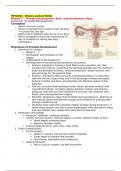Class notes
PSYC302 (Infancy) Module 3 & 4 Notes
- Course
- PSYC 302 (PSYC302)
- Institution
- University Of British Columbia (UBC )
This document contains detailed lecture notes from PSYC302 (Infancy) Modules 3 and 4, offering a comprehensive look into the early stages of human development. Module 3 focuses on prenatal development, covering the germinal, embryonic, and fetal stages, and the factors influencing them. The note...
[Show more]



